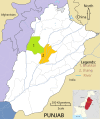Molecular epidemiology and phylogenetic insights of lumpy skin disease in cattle from diverse agro-ecological regions of Punjab, Pakistan
- PMID: 39804958
- PMCID: PMC11729989
- DOI: 10.1371/journal.pone.0315532
Molecular epidemiology and phylogenetic insights of lumpy skin disease in cattle from diverse agro-ecological regions of Punjab, Pakistan
Abstract
Lumpy skin disease (LSD) is an emerging, highly contagious transboundary disease of bovines caused by the Lumpy skin disease virus (LSDV), responsible for substantial economic losses to the dairy, meat, and leather industries in Pakistan as well as various countries around the world. Epidemiological information on LSD is scarce in Punjab, Pakistan. Therefore, a molecular epidemiological study was conducted in two agro-ecologically diverse districts (Bhakkar and Jhang) of Punjab, Pakistan. A total of 800 blood samples were randomly collected from the jugular vein of clinically suspected cattle with nodular lesions using a multistage cluster sampling technique. The sampling unit was indigenous, crossbred, and exotic breeds of cattle. Four hundred samples were collected from each district. Ten union councils (UC) were selected from each district, and two villages were selected from each union council. From each village, twenty cattle were selected for sample collection. The PCR-based overall prevalence of LSDV in clinically suspected cattle using the P32 gene was 36.25% (36.25%; 290/800). The multivariable logistic regression analysis indicated that animals who were not treated with acaricide (P = 0.014; OR = 1.459; C.I = 1.079-1.972), body condition score (emaciated animals; P = 0.019; OR = 1.573; CI = 1.076-2.301), and gender (female; (P = 0.016; OR = 1.435; CI = 1.072-1.969) were significantly at higher risk for LSDV infection in cattle. The phylogenetic insights revealed that our isolates were linked to Kenya, China, Russia, Egypt, India, Zimbabwe, Iraq, and Iran. It can be concluded that LSD is widely distributed in the study area, with evidence of genetic diversity. Further studies are required on genetic composition using variable genetic markers for effective control and eradication of LSDV in Pakistan.
Copyright: © 2025 Jabbar et al. This is an open access article distributed under the terms of the Creative Commons Attribution License, which permits unrestricted use, distribution, and reproduction in any medium, provided the original author and source are credited.
Conflict of interest statement
Authors declare no competing interest.
Figures



Similar articles
-
Molecular characterization of lumpy skin disease virus in the cattle population of District Lower Chitral, Khyber Pakhtunkhwa, Pakistan.Antonie Van Leeuwenhoek. 2025 Aug 3;118(9):124. doi: 10.1007/s10482-025-02137-1. Antonie Van Leeuwenhoek. 2025. PMID: 40754559
-
Lumpy skin disease (LSD) outbreaks in cattle in Odisha state, India in August 2019: Epidemiological features and molecular studies.Transbound Emerg Dis. 2020 Nov;67(6):2408-2422. doi: 10.1111/tbed.13579. Epub 2020 May 5. Transbound Emerg Dis. 2020. PMID: 32304275
-
Seroprevalence and molecular characterization of lumpy skin disease virus in Bahawalpur district of South Punjab, Pakistan.Pol J Vet Sci. 2025 Jan;28(1):93-101. doi: 10.24425/pjvs.2025.154017. Pol J Vet Sci. 2025. PMID: 40130955
-
Lumpy skin disease: Insights into current status and geographical expansion of a transboundary viral disease.Microb Pathog. 2024 Jan;186:106485. doi: 10.1016/j.micpath.2023.106485. Epub 2023 Dec 3. Microb Pathog. 2024. PMID: 38052279 Review.
-
A review: Surveillance of lumpy skin disease (LSD) a growing problem in Asia.Microb Pathog. 2021 Sep;158:105050. doi: 10.1016/j.micpath.2021.105050. Epub 2021 Jun 17. Microb Pathog. 2021. PMID: 34146642 Review.
Cited by
-
Epidemiology of Lumpy Skin Disease virus in large ruminants of Potohar region, Pakistan.Trop Anim Health Prod. 2025 Jul 21;57(7):310. doi: 10.1007/s11250-025-04557-7. Trop Anim Health Prod. 2025. PMID: 40691361
References
-
- Economic Survey of Pakistan, Government of Pakistan, Finance Division, Economic Advisor Wing, Islamabad. Chapter 2/Agriculture, 2023; p. 27. Available at: https://www.finance.gov.pk/survey/chapters_23/02_Agriculture.pdf. Accessed 24 September, 2023.
-
- Burranboina KK, Kumar KM, Reddy GBM, Yogisharadhya R, Prashantha CN, Dhulappa A. GC-MS analysis, molecular docking and pharmacokinetic studies of various bioactive compounds from methanolic leaf extracts of Leucas aspera (L) against anti-Capripox viral activity. Chem Data Collect. 2022; 39:100873. 10.1016/j.cdc.2022.100873 - DOI
-
- Biswas D, Saha SS, Biswas S, Sayeed MA. Outbreak of lumpy skin disease of cattle in South-West part of Bangladesh and its clinical management. Vet Sci Res Rev. 2020; 6:100–108. 10.17582/journal.vsrr/2020.6.100.108. - DOI
MeSH terms
LinkOut - more resources
Full Text Sources
Research Materials

